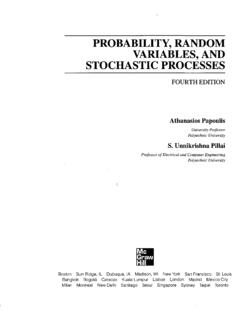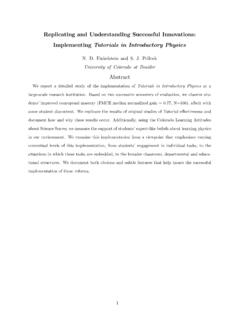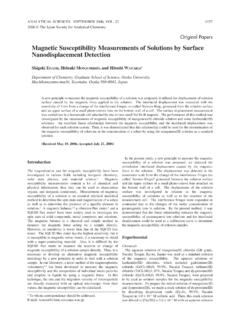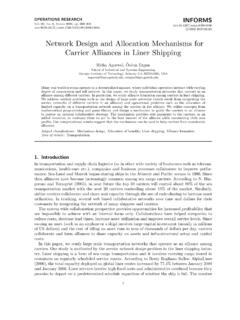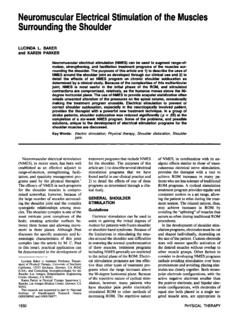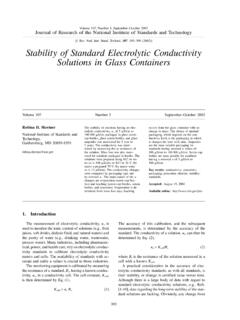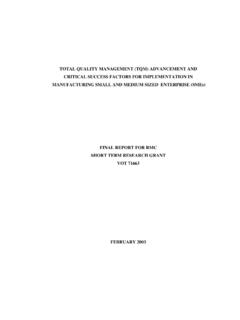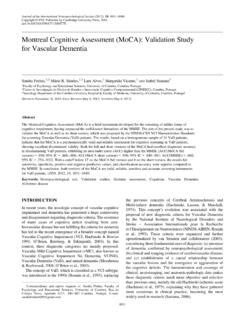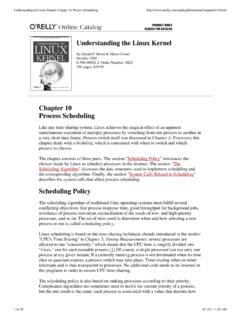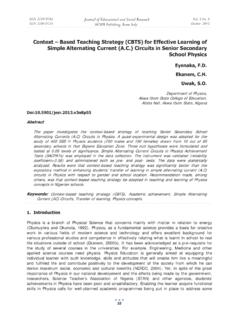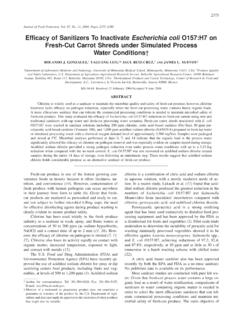Transcription of Safety and efficacy of different lanreotide doses in the ...
1 Safety and efficacy of different lanreotide doses in thetreatment of polycystic liver disease: pooled analysis ofindividual patient dataF. Temmerman*, T. Gevers , T. A. Ho , R. Vanslembrouck , W. Coudyzer , J. van Pelt*, B. Bammens , Y. Pirson ,J. P. Drenth & F. Nevens**Department and Laboratory ofHepatology, University HospitalsKULeuven, Leuven, Belgium. Gastroenterology and Hepatology,Radboud University, Nijmegen, theNetherlands. Department of Nephrology,Universit e Catholique de Louvain,Brussels, Belgium. Department of Radiology, UniversityHospitals KULeuven, Leuven, Belgium. Department of Nephrology,University Hospitals KULeuven,Leuven, to:Dr F. Temmerman, Department ofHepatology, University HospitalsKULeuven, Herestraat, 49, B-3000 Leuven, : dataSubmitted 9 March 2013 First decision 1 April 2013 Resubmitted 31 May 2013 Accepted 4 June 2013EV Pub Online 25 June 2013 SUMMARYB ackgroundLong-acting lanreotide (LAN) 120 mg every 4 weeks reduces liver volume (LV) inpatients with polycystic liver diseases (PCLD).
2 Animal studies demonstrated thatthe inhibition of hepatic and renal cystogenesis is dose investigate the Safety and efficacy of two different LAN doses in PCLD 6-month results of the LOCKCYST I trial, its extension study and the LOCK-CYST II trial were pooled. LV at baseline and month 6 was measured by CT-scanand blindly re-analysed by two independent study population [132 treatment periods, age 49 years (IQR: 45-55), 114women] consisted of three groups. Each received treatment every 4 weeks during6 months: placebo (n=26); LAN 90 mg (n=55) or LAN 120 mg (n=51). Theinter-observer variability and agreement in the calculation of LV were side effects occurred with placebo, LAN 90 mg and LAN 120 mg in respec-tively 0%, 7% and 16%. Change in LV s after 6 months in these three groups wererespectively: increase of+36 mL [(!)]
3 45) (+138)]; decrease of!82 mL [(!285) (+92)] and decrease of -123 mL [(!312) (+4)] (Kruskal-Wallis One WayANOVAonRanks;P= ). Based on ROC analysis, a reduction of 120 mL in LV has apositive predictive value of 64% for improving symptoms (ROC analysis ; sensitivity 73%, specificity 69%,P< ).ConclusionsBoth LAN 90 mg and LAN 120 mg reduce liver volume. LAN 90 mg has less sideeffects. This suggests that in case of intolerance to LAN 120 mg, a dose reductionto LAN 90 mg is Pharmacol Ther2013;38:397 406 2013 John Wiley & Sons Ltd397 Pharmacology and TherapeuticsINTRODUCTIONP olycystic liver disease (PCLD) is a chronic disorder inwhich numerousfluid-filled hepatic cysts are scatteredthroughout the liver. PCLD results from two inheriteddisorders: autosomal dominant polycystic kidney disease(ADPKD) or isolated polycystic liver disease (ADPCLD).
4 ADPKD is the most common inherited nephropathy andthe second most common inherited syndrome, affecting1/800 1000. It is characterised by a progressive develop-ment and enlargement of cysts originating from thenephrons, leading to renal failure in 50% of the affectedpatients. In addition, during their lifetime 83% of thesepatients also develop liver , 2 Patients sufferingfrom ADPCLD only present with liver cysts. The naturalhistory of PCLD, regardless of the genetic mutation, of the patients with PCLD are asymptomatic,but in 2 5% the expansion of liver cysts leads to symp-tomatic hepatomegaly. Symptoms include abdominaldistension, early satiety, dyspnoea and abdominal may lead to severe malnutrition, portal hyperten-sion and can be lethal. Liver cysts themselves displayalso their intrinsic complications: bleeding, infectionand/or , 4 Surgical treatment aims to reduceliver volume (LV) and includes a variety of proceduressuch as aspiration-sclerotherapy, laparoscopic or laparo-tomic fenestration and partial liver common to all of these procedures are thatthey are only partial effective; that they have a highmorbidity and most importantly that they do notchange the natural course of the disease.
5 Indeed, in themajority of the patients, the symptoms recur due to thegrowth of new cysts or re-growth of treated cysts. Inaddition, they are sometimes technically not possibleand therefore liver transplantation is sometimes the onlyreal , 7 Medical treatment became only recently available. Inthis regard, preclinical studies in the PCK rat (a recessivemodel of polycystic kidney and liver disease) showedthat the somatostatin analogue (SS-analogue) octreotide(Novartis Pharma, Basel, Switzerland) slows the progres-sion of hepatorenal cystogenesis by reducing 3 -5 -cyclicadenosine monophosphate levels in kidney and in bileducts. In the preclinical animal studies with octreotide,the inhibition of hepatic and renal cystogenesis was a randomised, placebo-controlled trial, weshowed that lanreotide Autogel (LAN) (somatuline,Ipsen Pharma, Beaufour, France) 120 mg is superior toplacebo for the treatment of PCLD by reducing LV andimproving aspects of quality of data inhumans were obtained using octreotide Long ActingRelease with a dose of 40 mg (octLAR 40 mg).
6 10 12It is not known which dose of somatostatin analoguesis needed to establish a volume reducing effect. This isrelevant as higher doses of somatostatin analogues haveinherent side effects. Well known side effects are steator-rhea, abdominal cramps andflatulence on the short termand gall-bladder stones on the long optimaldose ( efficacy vs. side effect balance) of somato-statin-analogues in the treatment of PCLD in patientshas never been the present study, we explored the Safety and theefficacy of two different doses of LAN: 90 mg and120 mg for the treatment of PCLD and the degree ofvolume reduction which offers symptomatic AND METHODSS tudy designIn our previous placebo-controlled study, we observedthat after 6 months more than 50% of the patients had areduction in LV of 100 mL or more when they receivedtreatment of LAN 120 mg.
7 Based on these data, wehypothesised that a 100 mL reduction in LV would beachieved in 40% of the patients treated with LAN90 mg. A power calculation for a randomised studydesign to demonstrate a dose-dependent effect showedthat each arm needed to contain 384 patients (signifi-cance level 5%; power 80%; 2-sided). As symptomaticPCLD is a rare disorder, it is unrealistic to recruit andrandomise such a high number of patients in an accept-able time period. Therefore, we decided to pool the indi-vidual data of the LOCKCYST I trial (clinical NCT00565097) and the 6 months data of itsextension study (clinical identifierNCT00771888), and the data of thefirst 6 months of theongoing LOCKCYST II trial (clinical identifierNCT01315795).Study populationThe patients enrolled in this study were followed ineither one of the collaborating universities: (i) UniversityHospitals KULeuven, Belgium; (ii) Radboud UniversityNijmegen Medical Centre, the Netherlands; and (iii)Universit e Catholique de Louvain, Brussels, patients were enrolled in the LOCKCYST Itrial from October 2007 till February 2008.
8 In thisrandomised, double-blind, placebo-controlled trial, 27patients were assigned to placebo and 27 to LAN398 Aliment Pharmacol Ther 2013; 38: 397-406 2013 John Wiley & Sons LtdF. mg. One female patient, who was randomly assignedto placebo, withdrew after 14 weeks because she wasdiagnosed with breast carcinoma. In the open-labelobservational extension study of the LOCKCYST I trial,24 patients who had received placebo in the initial studywere crossed over to LAN 120 mg (from April 2008 tillFebruary 2009). The data of thefirst 6 months of thesepatients were added to the study population. Finally, 57patients were included between January 2011 and July2012 in the LOCKCYST II trial, an open-label clinicalstudy to evaluate the Safety and efficacy of LAN 90 mg,including a dose escalation to LAN 120 mg in case ofnonresponder.
9 The data of thefirst 6 months in whichpatients were treated with LAN 90 mg/4 weeks trial dur-ing 6 month were added to the study population. Twopatients, who tolerated the treatment but received a LTbefore the 6 month follow-up visit, were excluded fromthis study. All CT-scans were blindly re-analysed in anonpaired way. Baseline characteristics (age, bodyweight, renal function) were systematically adjusted tothe treatment episode. We recruited three groups ofpatients: (i) placebo group (n=26); (ii) LAN 90 mggroup (n=55); (iii) and LAN 120 mg group (n=51).A comprehensive overview of the pooled patients data isgiven in Figure pointsThe primary end points of this study were to investigatethe Safety and the efficacy on LV of two doses of further investigated the minimal reduction in LVwhich resulted in an improvement of the symptoms ofthe patients and the predictors of response to treatmentwith LAN.
10 Secondary end points were the relativechange in kidney volume (KV) and changes in glomeru-larfiltration rates (eGFR) [Modification of Diet in RenalDisease (MDRD), mL/ m ].Measurement of volumetryAll patients underwent CT-scanning without contrastenhancement by the same device at enrollment and after6 months. The CT-scans were performed on differentmultidetector CT-scanners as available at the participat-ing centres: Siemens Somatom Sensation 16 (RadboudUniversity; Nijmegen Medical Centre); Siemens Som-atom Sensation 64 and Siemens Somatom DefinitionFlash (University Hospitals KULeuven) all from SiemensLOCKCYST I trialLOCKCYST I trial(Lockcyst I)LOCKCYST II trialOpen-label extensionOpen-label clinical study toevaluate the Safety and efficacyof LAN 90mg, including a doseescalation to LAN 120mg in caseof non-responderRandomized placebocontrolled trialRandomized placebocontrolled trial27 patients receivedplacebo for6 months27 patients receivedLAN 120mg for6 months57 patients receivedLAN 90mg first6 months27 patients receivingplacebo crossed overto LAN 120mgPlacebo groupn = 26 LAN 120mg groupn = 51 LAN 90mg groupn = 55 Studied treatment periodsn = 132 Breast carcinoma(n = 1)liver transplantationbetween baseline and6 months (n = 2)Figure 1 |Overview of the studied treatment periods (n=132).
